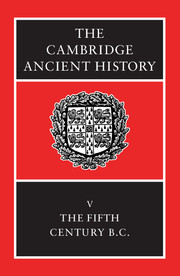Book contents
- Frontmatter
- Contents
- List of maps
- List of text-figures
- Preface
- 1 Sources, chronology, method
- 2 Greece after the Persian Wars
- 3 The Delian League to 449 b. c.
- 4 The Athenian revolution
- 5 Mainland Greece, 479–451 b. c.
- 6 The Thirty Years' Peace
- 7 Sicily, 478-431 b.c.
- 8 Greek culture, religion and society in the fifth century b.c.
- 9 The Archidamian War
- 10 The Peace of Nicias and the Sicilian Expedition
- 11 The Spartan Resurgence
- Chronological Notes
- Chronological Table
- BIBLIOGRAPHY
- Index
- 1 Greece and Western Asia Minor
- References
1 - Sources, chronology, method
Published online by Cambridge University Press: 28 March 2008
- Frontmatter
- Contents
- List of maps
- List of text-figures
- Preface
- 1 Sources, chronology, method
- 2 Greece after the Persian Wars
- 3 The Delian League to 449 b. c.
- 4 The Athenian revolution
- 5 Mainland Greece, 479–451 b. c.
- 6 The Thirty Years' Peace
- 7 Sicily, 478-431 b.c.
- 8 Greek culture, religion and society in the fifth century b.c.
- 9 The Archidamian War
- 10 The Peace of Nicias and the Sicilian Expedition
- 11 The Spartan Resurgence
- Chronological Notes
- Chronological Table
- BIBLIOGRAPHY
- Index
- 1 Greece and Western Asia Minor
- References
Summary
As far as source material is concerned, the period covered by this volume falls, for the writer of political history, into three sections, which present sharply contrasting problems of method. For the period from 435 to 411 b.c. Thucydides provides a firm framework. For the period from 478 to 435, he gives us some relatively full narrative on special points and a sketchy narrative from 477 to 440; the only connected narrative of any size is that by Diodorus Siculus. For 411 to 404 we have two connected narratives, by Xenophon and Diodorus.
Thucydides, son of Olorus of the deme Halimous, born perhaps about 460, was related in some way to Cimon and to Thucydides son of Melesias. Like Cimon, he had Thracian connexions, as is indicated by his father's name (cf. Hdt. VI.39.3) and his own statement (IV.105.1) that he had possessions in the gold mines east of the river Strymon which gave him great influence with the mainlanders of that area. Of his early life we know nothing, but can readily infer his total immersion in the intellectual excitement which the sophists were bringing to Athens. His military career begins and ends for us with his tenure of the generalship in 424/3 (p. 427 below). After his failure at Amphipolis he was in exile from Athens for twenty years (V.26.5), and this gave him the opportunity to watch events, not less from the Peloponnesian side; he says nothing of his ability to watch Athens.
Keywords
- Type
- Chapter
- Information
- The Cambridge Ancient History , pp. 1 - 14Publisher: Cambridge University PressPrint publication year: 1992
References
- 1
- Cited by

